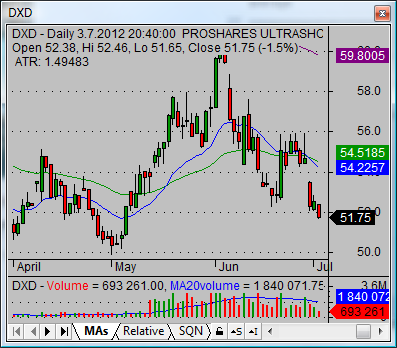Net Asset Value (NAV) Of The Amundi Dow Jones Industrial Average UCITS ETF

Table of Contents
What is Net Asset Value (NAV) and How is it Calculated?
The Net Asset Value (NAV) represents the intrinsic value of an ETF's holdings. For the Amundi Dow Jones Industrial Average UCITS ETF, which tracks the Dow Jones Industrial Average, the NAV reflects the total value of its underlying assets, minus any liabilities, divided by the number of outstanding shares. This calculation provides a snapshot of the ETF's worth on a specific day.
Understanding the NAV calculation is key to assessing ETF performance and comparing it to similar investment vehicles. The process is relatively straightforward:
- NAV reflects the intrinsic value of the ETF's holdings. This means it shows the actual value of the assets the ETF owns, not just its market price.
- Calculated daily, typically at the market close. The NAV is usually calculated at the end of each trading day, reflecting the closing prices of the underlying assets.
- Formula: (Total Asset Value - Liabilities) / Number of Outstanding Shares. This simple formula underpins the NAV calculation. Total asset value includes the market value of all the stocks within the ETF. Liabilities encompass any expenses or obligations the fund has.
- Illustrative example: Let's imagine a simplified ETF with 100,000 shares, holding only two stocks: Stock A (worth $1 million) and Stock B (worth $500,000). If the ETF has liabilities of $10,000, the NAV would be: ($1,500,000 - $10,000) / 100,000 = $14.90 per share. This is a simplified illustration; real-world ETFs have much more complex portfolios.
Factors Affecting the NAV of the Amundi Dow Jones Industrial Average UCITS ETF
The NAV of the Amundi Dow Jones Industrial Average UCITS ETF fluctuates daily, primarily driven by the performance of its underlying assets – the 30 companies comprising the Dow Jones Industrial Average. Several other factors contribute to these daily changes:
- Performance of the underlying Dow Jones Industrial Average stocks: This is the most significant factor. If the Dow Jones Industrial Average rises, the NAV of the ETF will generally increase, and vice-versa.
- Impact of dividends from the underlying holdings: When the companies in the Dow Jones Industrial Average pay dividends, the ETF receives these dividends, which increase the total asset value and, consequently, the NAV.
- Currency exchange rate fluctuations (if the ETF holds non-Euro denominated assets): While the Amundi Dow Jones Industrial Average UCITS ETF primarily tracks a US index, currency fluctuations could indirectly influence the NAV if there are any currency exposures within the fund's operations.
- The effect of the ETF's expense ratio on the NAV: The expense ratio, which covers the ETF's operational costs, is deducted from the fund's assets and therefore slightly reduces the NAV over time.
NAV vs. Market Price of the Amundi Dow Jones Industrial Average UCITS ETF
While the NAV represents the theoretical value of the ETF, the market price is the actual price at which the ETF trades on the exchange. These two values are usually close, but discrepancies can occur due to several reasons:
- NAV is the theoretical value; market price is what the ETF trades for on the exchange. The market price reflects supply and demand in the market.
- Small discrepancies are normal due to market liquidity. The bid-ask spread (the difference between the buying and selling prices) contributes to these minor differences.
- Significant deviations could indicate market inefficiencies or unusual trading activity. Large discrepancies might warrant further investigation.
- Illustrative example: The ETF's NAV might be €15.00, but its market price might be €15.02 or €14.98, due to market forces.
Where to Find the NAV of the Amundi Dow Jones Industrial Average UCITS ETF
Staying informed about the Amundi Dow Jones Industrial Average UCITS ETF NAV is easy. You can find up-to-date information from various sources:
- Amundi's official website: The most reliable source is usually the asset management company's website.
- Major financial news providers (e.g., Bloomberg, Yahoo Finance): Many financial websites provide real-time or end-of-day NAV data for various ETFs.
- Your brokerage account statement: Your brokerage account will show the NAV of your ETF holdings.
Conclusion
Understanding the Net Asset Value (NAV) is paramount for anyone investing in the Amundi Dow Jones Industrial Average UCITS ETF or any other ETF. This article highlighted the NAV's importance, its calculation, the factors influencing it, and the difference between NAV and market price. By actively monitoring the Net Asset Value of your investment, you can effectively track its performance and make informed decisions regarding your portfolio. Remember to analyze the Amundi Dow Jones Industrial Average UCITS ETF NAV alongside other key metrics before making any investment decisions. Compare different ETFs, track their performance, and actively monitor the NAV to ensure you’re making the best investment choices for your financial goals.

Featured Posts
-
 Recenzja Porsche Cayenne Gts Coupe Plusy I Minusy
May 25, 2025
Recenzja Porsche Cayenne Gts Coupe Plusy I Minusy
May 25, 2025 -
 Annie Kilners Posts Following Kyle Walker Night Out Allegations Of Poisoning
May 25, 2025
Annie Kilners Posts Following Kyle Walker Night Out Allegations Of Poisoning
May 25, 2025 -
 The Future Of Healthcare Analyzing The Philips Future Health Index 2025 Predictions On Ai
May 25, 2025
The Future Of Healthcare Analyzing The Philips Future Health Index 2025 Predictions On Ai
May 25, 2025 -
 Chetyre Pobeditelya Evrovideniya 2025 Po Versii Konchity Vurst
May 25, 2025
Chetyre Pobeditelya Evrovideniya 2025 Po Versii Konchity Vurst
May 25, 2025 -
 M56 Traffic Updates Motorway Closure Following Serious Crash
May 25, 2025
M56 Traffic Updates Motorway Closure Following Serious Crash
May 25, 2025
